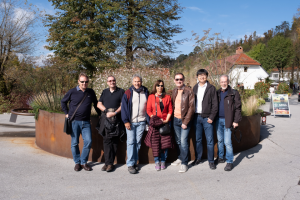Categories
Archives
This is part of a series of posts about the IPTC Autumn Meeting 2019. In Ljubljana. See separate posts about Day 1 and Day 2.
Day 3 of the Ljubljana Meeting was where we got down to business: we hosted the 2019 IPTC Annual General Meeting, where Voting Members get to have their say on how the organisation is run, voting on the budget and the Board.
We are very happy to announce that Jennifer Parrucci of the New York Times and Paul Harman of Bloomberg were both voted as new IPTC Board members and Directors of the company, and that Robert Schmidt-Nia of DPA was voted as Chair of the IPTC Board.
On behalf of all IPTC members we would like to say thanks, and welcome!
Then we had the IPTC Standards Committee meeting where we approved the latest versions of two of our key standards: IPTC Photo Metadata Standard 2019.1 and ninjs 1.2. Stay tuned for more information on both of those very soon!
In the afternoon we had a visit to the Triglav Lab where we were able to see some interesting developments in the Slovenian tech scene related to media. Thanks again to Aljoša Rehar from STA and Marko Grobelnik from Jožef Stefan Institute for their help in organising the afternoon.
We heard from:
- Event Registry , a “news intelligence platform” that semantically tags content to identify meaning and disambiguate between potential meanings for the same words, allowing for cross-language tagging and clustering to create “news events” across articles in multiple languages
- Embeddia, a JSI project in partnership with STT Finland and Ekspress meedia in Estonia, looking at using structured data to create “intelligence augmentation”, as opposed to AI, helping journalists to do their jobs better. It also focuses on less-popular languages such as Slovene, Finnish and Estonian where some standard AI tools don’t work as well.
- Internal projects at STA including an article tracker which allows the agency can track usage of their content, even if it is modified; a tool called D4 which allows STA to see which stories they have been missing and how they can find new stories; and Newsmapper which provides analytics about STA’s own content – where was it popular? with what types of readers?
- Behaviour Exchange, a user analytics tracker that allows publishers to understand their users’ demographics and preferences, including their own ad network, rather than outsourcing their user analytics to the big platforms.
- A representative from Blockchain Think Tank Slovenia spoke about media implications of blockchain and what it could do for the media industry.
- Finspektor showed how they are used open data to analyse how the Slovenian government is spending their taxpayers’ money
- and Parlameter showed how they are bringing politicians to account, showing their activity in parliament, on social media and in the media.

It was a great way to end a fascinating three day event!
And on the Thursday some of us were able to go on a networking day to Postojna Cave where we were able to see the beautiful tunnels and some very impressive underground. Some of us were also able to go on to the stunning Lake Bled, which we definitely would recommend!
Thanks again to Aljoša, Nejc, Marjana, Marko and the team from STA and JSI for helping to organise the event.